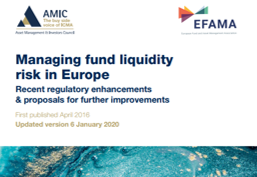EFAMA shared its views on the EBA’s Draft Guidelines on policies and procedures in relation to compliance management and the role and responsibilities of the AML/CFT Compliance Officer under Article 8 and Chapter VI of Directive (EU) 2015/849 (the ‘Draft Guidelines’).
Management Companies
EFAMA has been looking at legislative proposals with a direct impact on asset management companies and services, and closely follows any regulatory developments of critical importance to the sector. In addition to issues related to risk management and financial stability, high up on the agenda of EFAMA members is the framework for a prudential regime for Investment Firms (IFD/R), and related implementing measures directly descending from such framework.
EFAMA is focused on minimising the impact of the rules on asset management companies, in particular those holding a limited MiFID license. Key to the sector is the need for proportionality, especially firms that are not authorised to hold client money/securities, or to deal on their own account.
EC Public Consultation on draft Guidelines on the role, tasks and responsibilities AML/CFT compliance officers
EFAMA's response to the EBA consultation on draft RTS criteria for the identification of shadow banking entities
Ever since the term “shadow banking” has emerged from the FSB’s working circles in the immediate aftermath of the 2008 global financial crisis[1], our association has consistently argued that its use as a reference to regulated asset management companies and their funds is inaccurate and mis-leading.
Distance marketing of consumer financial services – Review of EU rules
EFAMA provided high-level comments to the Commission’s consultation on the potential review of the Directive on Distance Marketing of Consumer Financial Services.
We agree with the Commission’s interpretation that the Directive is seen as a “safety net” for financial services not already subject to product-specific legislation. Fund and asset managers are already subject to various, more stringent and detailed sectoral legislations, such as (but not limited to) UCITS, AIFMD and MiFID as well as the (more recent) Cross-Border Fund Distribution Directives.
European Alternative Fund Managers Directive stands the test of time
The European Fund and Asset Management Association (EFAMA) has published today its response to the European Commissions public consultation on the review of the Alternative Investment Fund Managers Directive (AIFMD).
Monthly Statistics November 2020 | News of vaccines drove record net sales of UCITS equity funds
The European Fund and Asset Management Association (EFAMA) has today published its latest monthly Investment Fund Industry Fact Sheet, which provides net sales data of UCITS and AIFs for November 2020*.
Monthly Statistics October 2020 | Inflows in bond funds drive positive UCITS net sales in October
The European Fund and Asset Management Association (EFAMA) has today published its latest monthly Investment Fund Industry Fact Sheet, which provides net sales data of UCITS and AIFs for October 2020*.
Bernard Delbecque, Senior Director for Economics and Research commented: "Net sales of UCITS equity funds, although remaining positive, fell to a very low level in October against the backdrop of increases in Covid-19 cases and new lockdown measures."
The main developments in October 2020 can be summarized as follows:
Annual Review June 2019-June 2020
"It gives me great pleasure to provide you with an overview of our activities since our Annual General Meeting in Paris last year. While we were very much looking forward to hosting you all in Brussels this week, the current crisis and associated travel restrictions has forced us to improvise and turn our meeting into a virtual AGM.
Investment Funds Distributor Due Diligence Questionnaire
Funds face unique challenges in performing intermediary oversight, and especially so because of MiFID II requirements, changing regulatory landscapes, and the absence of an industry agreed-upon standard between funds and their distribution channels. To help address these challenges, a dedicated working group developed a uniform due diligence questionnaire (DDQ) that will serve as the standard for investment funds (UCITS and AIFs) in performing onboarding and ongoing oversight of distribution channels.
AMIC EFAMA Report - Managing fund liquidity risk in Europe - 2020
In 2019, AMIC and EFAMA decided to update their 2016 report “Managing Fund Liquidity Risk in Europe” following important policy and regulatory developments at EU and international levels. The purpose of this updated report is to outline the practical liquidity risk management processes which fund management companies put in place when setting up a fund and implement throughout the life of the fund. Also, the report describes the existing European and international regulatory frameworks in the area of fund liquidity risk management.




































